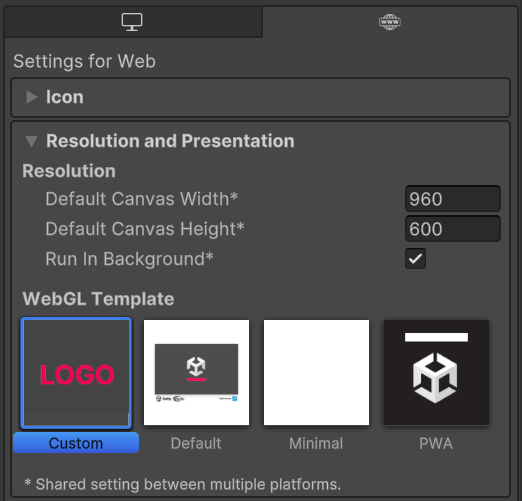Web template structure and instantiation
Use custom user variables in a template’s index.html file and create a new instance of your content with createUnityInstance().
For information about template variables, JavaScript macros, and conditional directives, refer to Web template variables.
To add a custom Web template, refer to Add a custom Web template.
Custom user variables
When you select a Web template, Unity parses the template and looks for JavaScript macros and conditional directives.
Unity treats JavaScript variables as custom user variables if they’re:
- Used inside JavaScript macros and conditional directives.
- Not declared in the template code.
- Not internal pre-processor variables.
Unity automatically adds these custom user variables to the Resolution and Presentation section in the Player SettingsSettings that let you set various player-specific options for the final game built by Unity. More info
See in Glossary window.
As an example, if you want to control the title of the generated index.html page directly from the Player Settings window, you first need to modify the <title> line of the index.html in your custom template, like this:
lang-html
<title>{{{ PAGE_TITLE }}}</title>
After you have done this, re-select your custom template. This parses the template again, and a Page Title field appears in the Resolution and Presentation > Web Template section of the Player Settings window.

When you enter text into this field and build your project, the custom variable PAGE_TITLE in the template macro automatically becomes the text in the Page Title field.
If you would like to use custom integer or float variables in your macros, use parseInt() or parseFloat() JavaScript functions in your macros to preprocess string values supplied by the Unity Editor. This is because custom user variables are always assigned a string value.
Note: Underscore characters in variable names display as spaces inside the field to improve readability.
Structure of the index.html file
The index.html contains the code necessary to load the build and should include the following:
- A
<canvas>element. Unity runtime uses the<canvas>element to render the application. - JavaScript code to download the build loader. For example:
var buildUrl = "Build";
var loaderUrl = buildUrl + "/{{{ LOADER_FILENAME }}}";
var script = document.createElement("script");
script.src = loaderUrl;
script.onload = () => {
// code for instantiating the build
};
document.body.appendChild(script);`
In this example, {{{ LOADER_FILENAME }}} is automatically resolved by the template preprocessor when the build is generated.
Alternatively, you can download the build loader using a script tag, for example:
lang-js
<script src="Build/{{{ LOADER_FILENAME }}}"></script>
- JavaScript code for instantiating a build. Unity builds are instantiated using the
createUnityInstance()function, which is defined in the build loader script.
The instantiation function: createUnityInstance()
The createUnityInstance() function creates a new instance of your content. You can use it like this:
lang-js
createUnityInstance(canvas, config, onProgress).then(onSuccess).catch(onError);
This function returns a Promise object, where:
| Object | Use |
|---|---|
canvas |
Unity runtime uses the canvas object to render the game. |
config |
The config object contains the build configuration, such as the code and data URLs, product and company name, and version. For more information on config definition, refer to Web template build configuration and interaction. |
onProgress(progress) {...} |
The Web loader calls the onProgress callback object every time the download progress updates. The progress argument that comes with the onProgress callback determines the loading progress as a value between 0.0 and 1.0. |
onSuccess(unityInstance) {...} |
The onSuccess callback is called after the build has successfully instantiated. The created Unity instance object is provided as an argument. This object can be used for interaction with the build. |
onError(message) {...} |
The onError callback is called if an error occurs during build instantiation. An error message is provided as an argument. |
The createUnityInstance() function is defined in the build loader script and is specific to the instantiated build. Therefore, if you’re embedding two or more builds in the same HTML document, make sure that the createUnityInstance() function is called from an onload callback of the corresponding build loader script. For more information about the Unity Web Loader, refer to Web Build folder and Web template structure and instantiation.